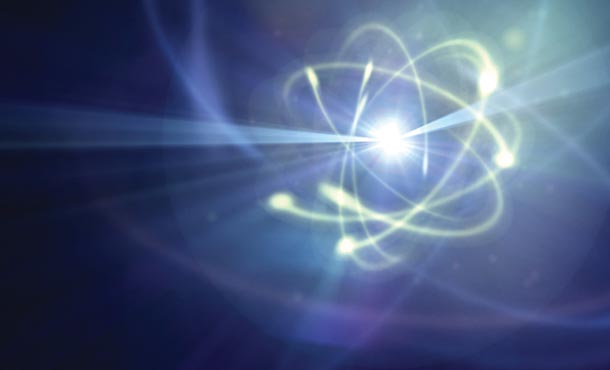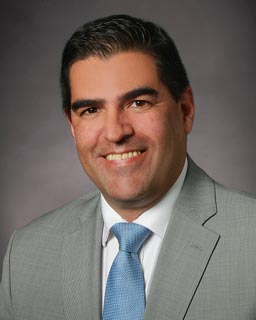
The future of nuclear engineering at Penn State and beyond
1/24/2020
By Ashley WennersHerron
UNIVERSITY PARK, Pa. — The Ken and Mary Alice Lindquist Department of Nuclear Engineering is newly named, once more independent and under new leadership.
The department, formally established in 1959, joined with the Department of Mechanical Engineering in 1997. The two departments were separated in the summer of 2019, the year after nuclear engineering received an endowment from Ken and Mary Alice Lindquist. Jean Paul Allain joined Penn State from the University of Illinois at Urbana-Champaign to lead the department. Allain also holds the Lloyd and Dorothy Foehr Huck Chair in Plasma Medicine in the Huck Institutes of the Life Sciences. He is also an Institute for Computational and Data Sciences faculty co-hire and professor of biomedical engineering by courtesy.
Engineering Penn State sat down with Jean Paul Allain, department head of the Ken and Mary Alice Lindquist Department of Nuclear Engineering, to discuss the future of the department and its role in shaping the future of nuclear engineering across the world.
Engineering Penn State (EPS): What is nuclear engineering at Penn State? What areas does it encompass?
Jean Paul Allain (JPA): Penn State nuclear engineering has a prestigious history in the field and, in particular, in nuclear power and nuclear safety. Nuclear engineering is one of the most multidisciplinary areas in all of engineering, especially when you think about where the heart of the discipline was born — the study of how radiation interacts with matter. Nuclear science is the convergence of classical and quantum physics and exploiting the manipulation of changes in the nucleus of an atom. Beyond nuclear power, radiation is used in medicine to treat cancer and as radio tracers to identify disease, and in food science to disinfect materials we’ll consume. Nuclear power and nuclear energy are links to sustainability, which requires policy and regulation. The Ken and Mary Alice Lindquist Department of Nuclear Engineering and Penn State as a whole are key players in determining the huge impacts nuclear power will have on our future and beyond.
EPS: In which areas will the department grow to support this future work?
JPA: For many decades, nuclear engineering at Penn State has focused on nuclear power and areas aligned with nuclear power, such as nuclear safety analysis. Those are still critical areas, and they’ll be a major part of our portfolio, which we plan to expand in complementary areas. For example, we’re exploring more compact nuclear reactors. These aren’t just smaller, but more modular. These are reactors that can be built at a factory and transported where they’re needed. I’m particularly excited about the prospects of molten salt reactors and the innovation around micro reactors. These could one day address issues in climate change, poverty, water desalination and industrial heating to scale; transforming emergent economies across the globe. We’re also expanding our research into advanced technologies in plasma and nuclear space physics, such as nuclear fusion, plasma medicine and space nuclear propulsion.
EPS: How will the expanded research portfolio change the student experience?
JPA: For undergraduate students in particular, they’re joining the discipline as it is transforming itself nationally and internationally. The future nuclear engineer will think globally and have a keen appetite for learning with an entrepreneurial mindset to bring about transformational innovations in nuclear technology. Our undergraduate program will have more practical experiences in all sectors of nuclear engineering, including policy and law. Our students will have these experiences at Penn State as well as across the country in national labs and even abroad. We’ll begin to prepare students for these experiences with advanced labs that encourage learning by doing, with hands-on practicums integrated into lectures. Innovation and entrepreneurship will be integrated into courses to encourage students to understand what it means to actually practice in nuclear engineering. We’ll also encourage students to approach nuclear engineering with a multidisciplinary view: students should collaborate with peers from other fields, such as liberal arts and business, so they can work together to solve highly complex problems from a variety of perspectives. We will also encourage all undergraduates to work in a research lab with fellow grad students and world-renown faculty. For graduate students, their experience will be tightly linked to the faculty we recruit. We expect the graduate cohort to double from about 50 now to about 100 in five years, as we recruit exceptional faculty and they grow their research programs.
For both students, and recruiting and retaining faculty, a major focus is on our facilities. The Radiation Science & Engineering Center, which houses the Breazeale Reactor, is a world-class facility and we will continue to partner in new initiatives creating a unique ecosystem of engagement for students and faculty members from across all of Penn State.
EPS: Beyond Penn State, what are your plans for developing the department and building continuing relationships with alumni?
JPA: Our responsibility is to engage with Penn State alumni and encourage them to become mentors, advocates, teachers, and partners with our students and faculty. We’re identifying opportunities for alumni and friends to engage with the department, with the goal of assembling a world-renown alumni and advisory board to engage with all stakeholders and help guide large-scale strategic planning as we shape the vision of the department. They bring ideas of innovation and entrepreneurship and the ability to train our students to be equipped with these ideals. Industry is also incredibly important to our department. We want to increase our footprint with industry partners, both for the importance of how industry influences our curriculum to provide our students with real experience, as well as for faculty and students to have that facetime with industry.
EPS: With the department’s new name, and your appointment as the head of the department, this has been referred to as the department’s inaugural year. What does that mean?
JPA: It means we’re cherishing our history and establishing our new identity for the 21st century. The department history dates back to the 1950s and includes the visionary work of such scholars as Forrest Remick, Anthony Foderaro, Larry Hochreiter and more. Our legacy is unique, with so many people who have contributed to our rich history. We’re not forgetting that — we’re building on it and expanding to shape and define our future. This year of new opportunities, including new leadership and a generous gift from the Lindquists, is our first year of transformation.
When you think about the importance of energy to the world, and a sustainable solution to provide energy, nuclear generation is a critical component. We need to rethink how nuclear power and nuclear engineering is perceived and that includes the technology, the policies, the economics, the regulation. How we shape the definition of nuclear energy and sustainability will determine how humanity uses this incredible source of energy to achieve carbon-free goals by 2050 and beyond. Nuclear power is not the only answer, but we are certainly a critical part of the future.
EPS: What is your ultimate goal as department head?
JPA: My first goal is also my challenge. The perception of nuclear energy, and, by extension, nuclear engineering, carries a lot of history. I want to address that narrative, and help people understand the true nature and potential of nuclear science and engineering. This includes navigating the current state of nuclear energy to get young people excited about the discipline. It also means educating the public by communicating the vast multidisciplinary nature of nuclear science and engineering. My vision for nuclear engineering at Penn State is one that extends beyond where nuclear has been and driven by what nuclear can become. By working together with faculty, we are defining nuclear engineering not just for the next 25 years, but for the next century.
As a department head, my position is one of service. I’m here to serve the faculty, the students, and the alumni. Our discipline is intrinsically global. It’s imperative that we seek inclusive and diverse perspectives that enrich our learning, research, and innovation. My ultimate goal is to bring this department to the next level, to bring a variety of vantage points to the forefront of our innovation and to enable us to be the top nuclear engineering program in the country.
Note: This story originally appeared in Engineering Penn State, the magazine of the Penn State College of Engineering.




